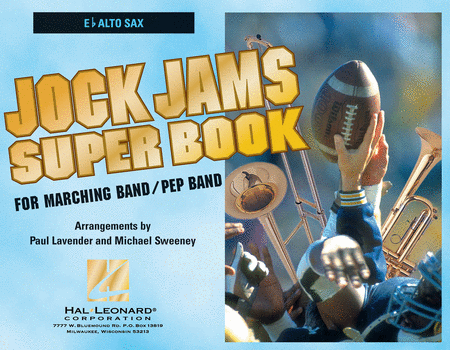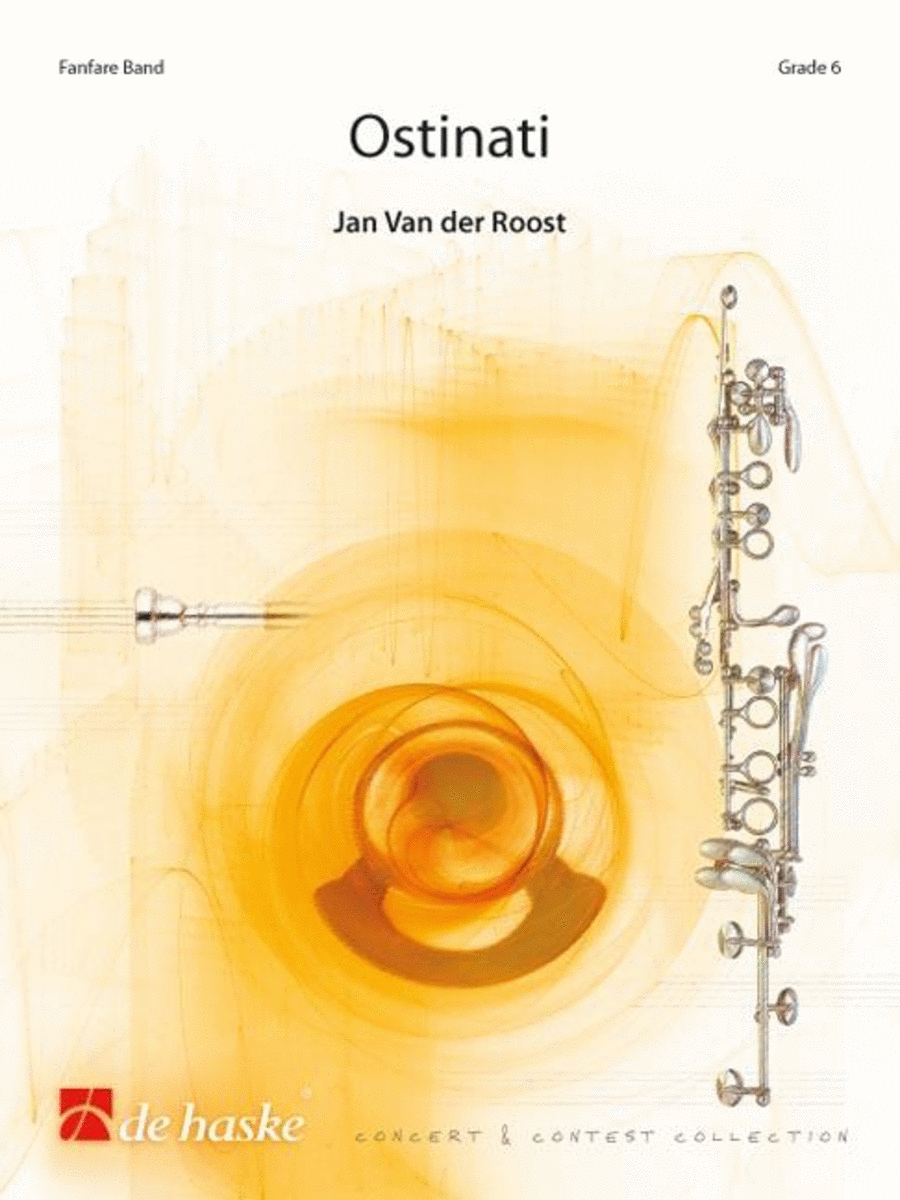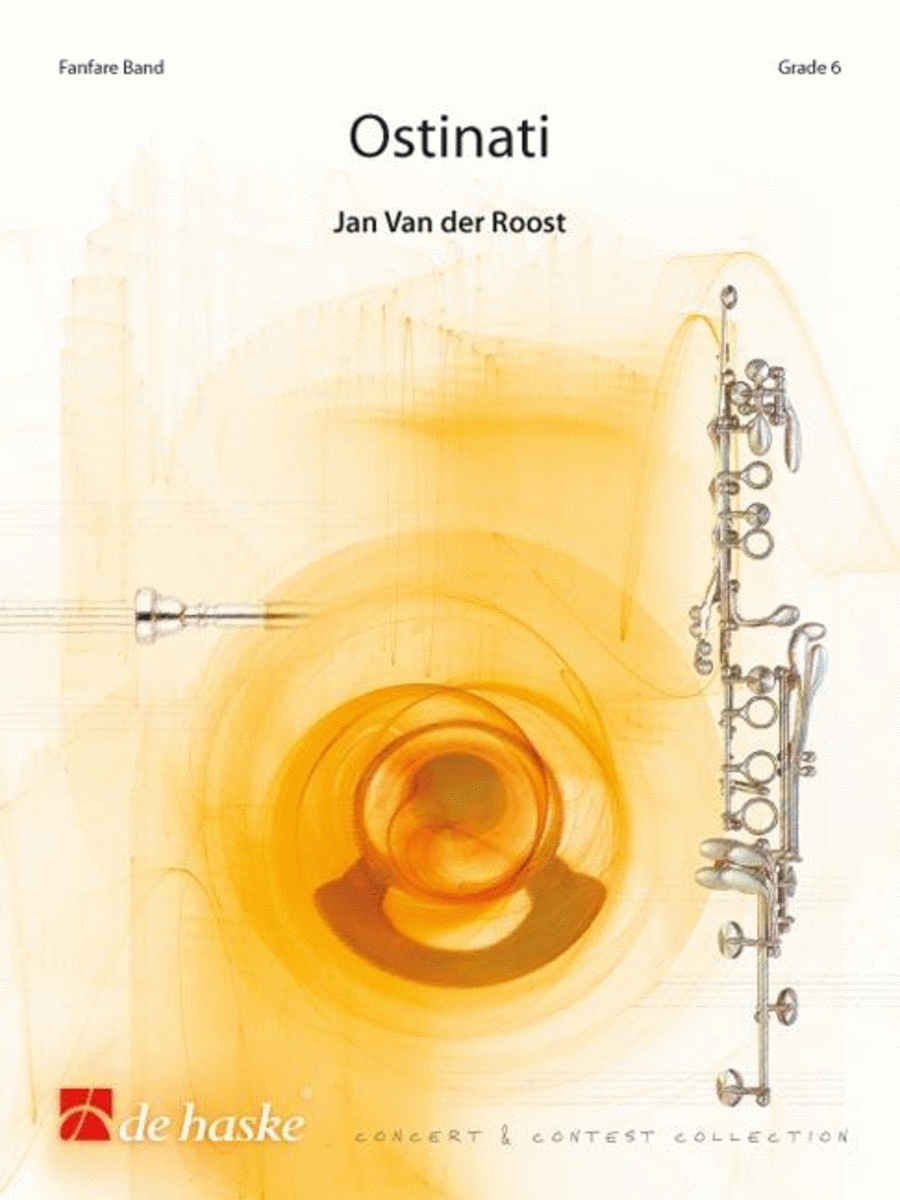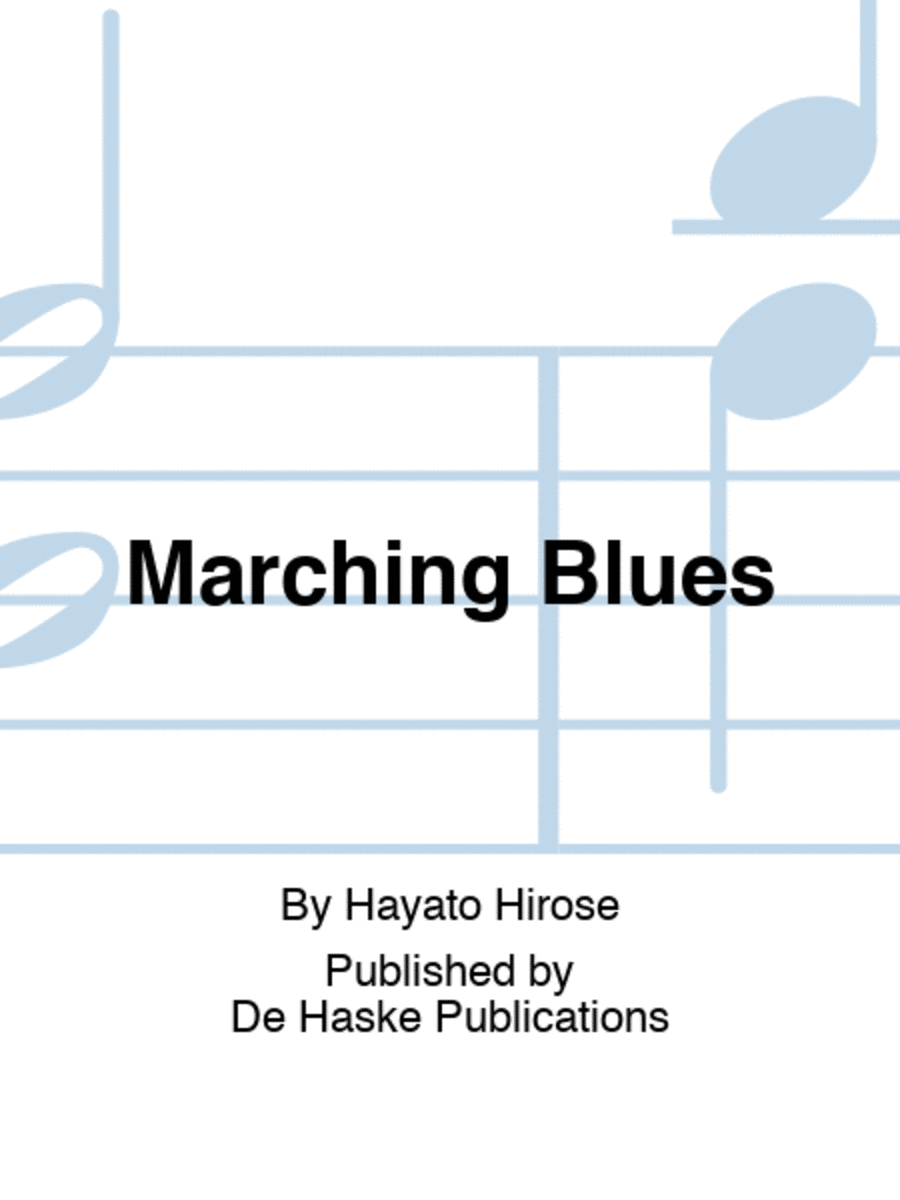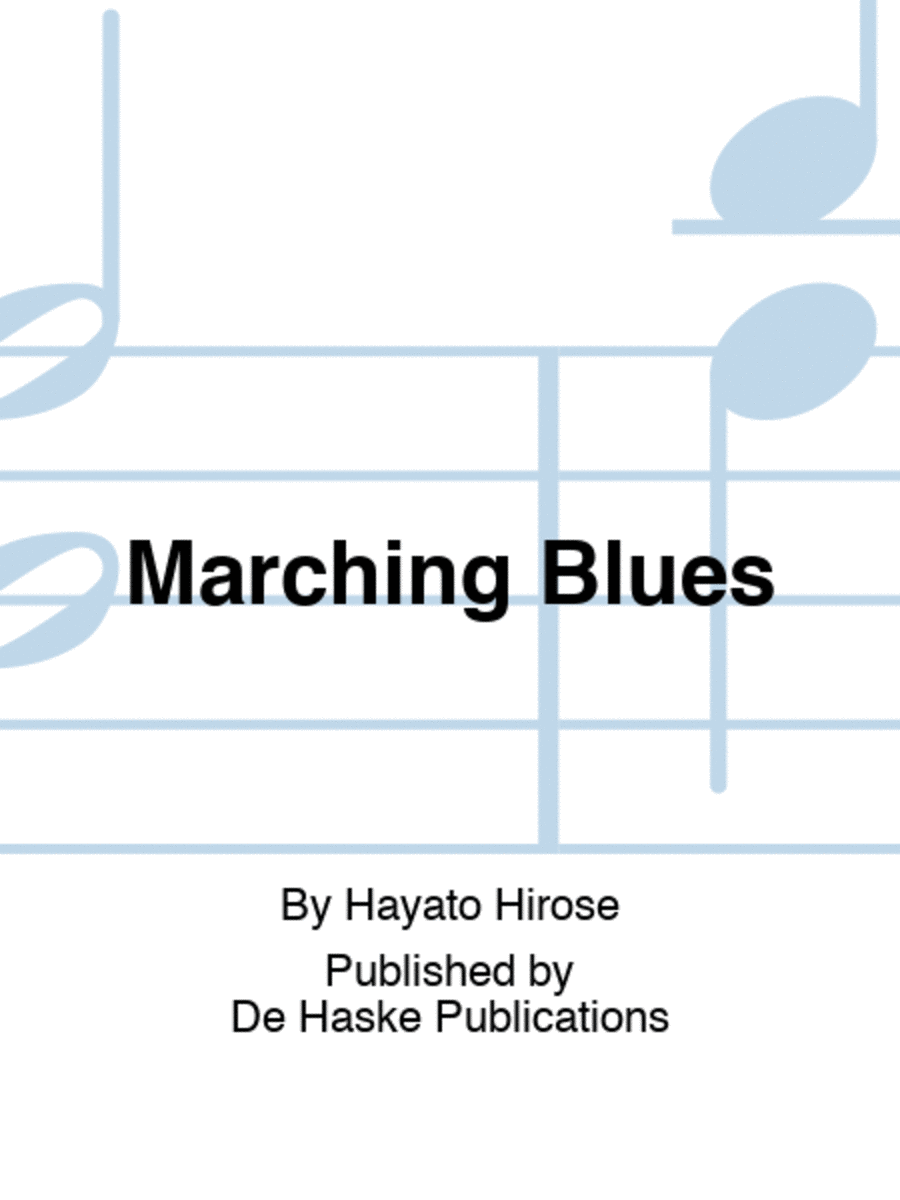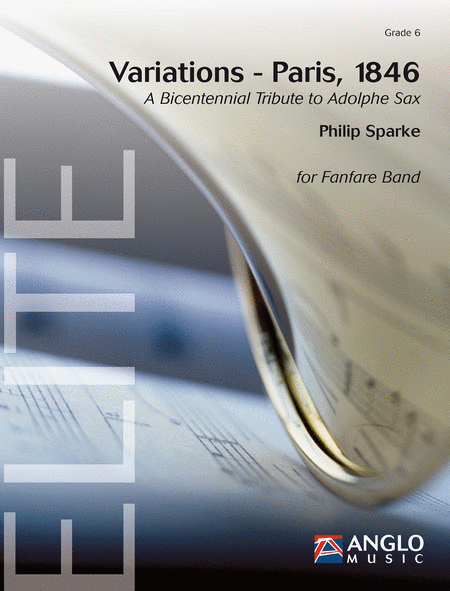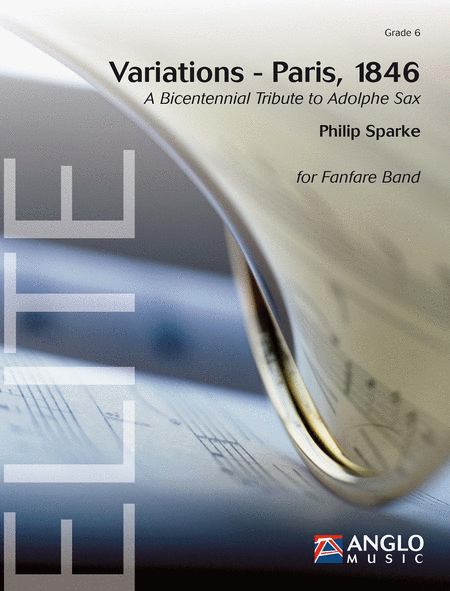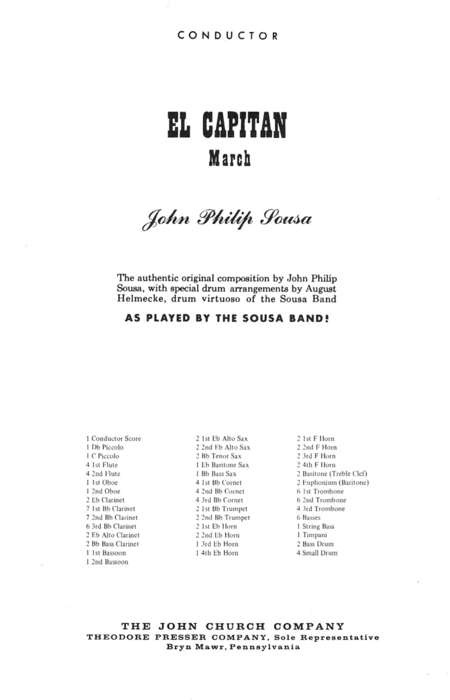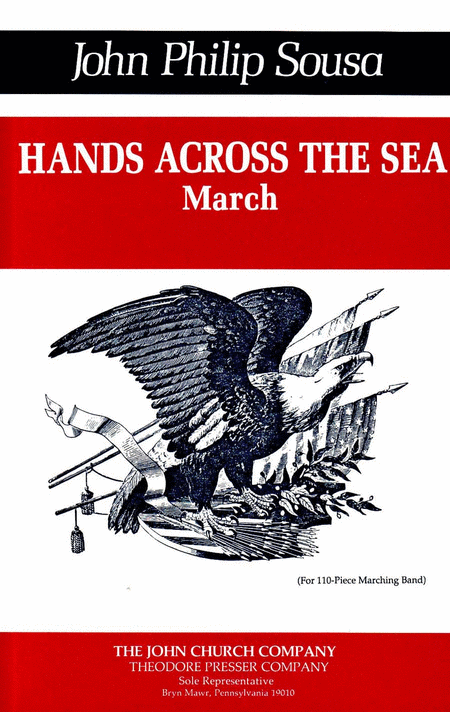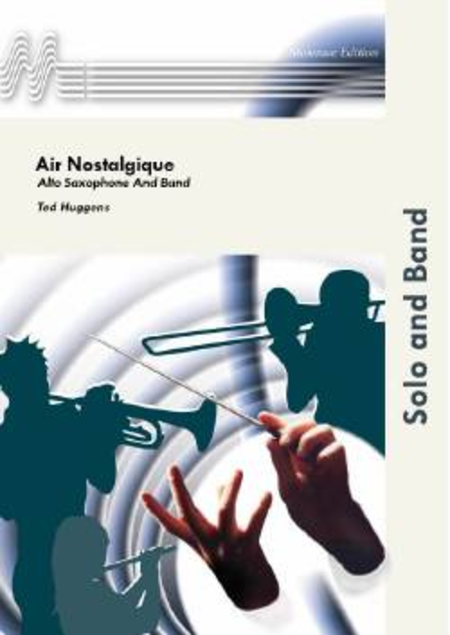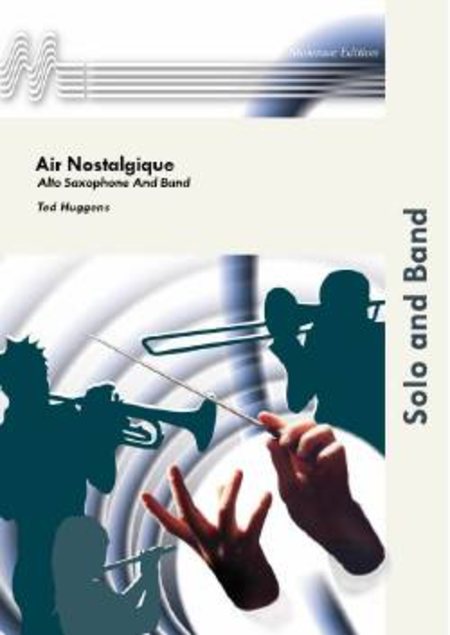|
| Jock Jams Super Book - Eb Alto Saxophone
Fanfare [Partie séparée]
Hal Leonard
Part for Eb alto saxophone. Series: Hal Leonard Contemporary Marching Band. 16 p...(+)
Part for Eb alto
saxophone. Series: Hal
Leonard Contemporary
Marching Band. 16 pages.
Published by Hal Leonard.
$3.99 - Voir plus => AcheterDélais: 24 hours - In Stock | | | |
| Ostinati
Fanfare [Conducteur et Parties séparées] - Intermédiaire/avancé
De Haske Publications
Fanfare Band - Grade 6 SKU: BT.DHP-1115084-020 Composed by Jan Van der Ro...(+)
Fanfare Band - Grade 6
SKU:
BT.DHP-1115084-020
Composed by Jan Van der
Roost. Concert and
Contest Collection CBHA.
Set (Score & Parts). De
Haske Publications #DHP
1115084-020. Published by
De Haske Publications
(BT.DHP-1115084-020).
9x12 inches.
English-German-French-Dut
ch. It may be
surprising to see a
fanfare piece
commissioned by a
Japanese ensemble, since
fanfare orchestras are
typically found in
Belgium, Holland and
Luxembourg, and also
France and Switzerland.
Senzoku Gakuen is one of
the largest and
mostprestigious music
universities in Japan,
and home to a wide
variety of ensembles and
orchestras. Since 2006
they have had a fanfare
orchestra, which was
started by Sotaru
Fukaishi, a euphonium
teacher who felt further
performance opportunity
wasneeded for saxhorn
instruments. Fukaishi had
loved the sound of
fanfare orchestras ever
since visiting the World
Music Contest in Kerkrade
(Holland) several years
earlier. Jan Van der
Roost was involved with
this new initiative from
the beginning,and they
were also joined by Manu
Mellaerts for certain
projects. The Dean of the
music department,
Professor Kazuo Tomioka,
fully supports the
ensemble and commissioned
Ostinati. The
première took place on
June 11th at Maeda Hall
inMizonokuchi (Kawasaki)
where Senzoku Gakuen is
based. The piece opens
with an impressive
timpani solo, followed by
brass and saxophone. The
rhythmical pulse remains
constant and the music is
fiery and assertive in
character. A pentatonic
melodygradually emerges
and the music loses its
vehemency and softens.
The initial percussion
ostinati subsequently
recurs and the first
section of the piece
concludes in a similar
mood to the opening. The
second movement is sweet
and melodic, opening
witha long passage for
the saxophone family in a
minor key. The same theme
then appears in the major
and is developed upon;
the music builds to a
majestic orchestral
forte, reminiscent of a
pipe organ in its
sonority. The theme
returns in the
originalminor key with a
change in instrumentation
leading the movement to a
quiet and peaceful end on
a soft E minor chord. The
finale starts with
percussion: a four-bar
pattern is repeated
several times over which
the movement’s
melodic themes
areintroduced. These
melodic elements are
varied and used in
different versions and
the ostinato idea, which
characterizes the entire
piece, is highlighted.
The theme travels through
the orchestra, appearing
on various instruments
and in variousregisters.
It captures the
listener’s
attention and displays
the full range of sound
and colour within the
fanfare
orchestra.
Het is
misschien verrassend dat
dit fanfarewerk is
geschreven in opdracht
van een Japans ensemble,
aangezien fanfareorkesten
vooral te vinden zijn in
België, Nederland en
Luxemburg, en ook wel in
Frankrijk en Zwitserland.
SenzokuGakuen is een van
de grootste en meest
prestigieuze
muziekopleidingen van
Japan, en de thuisbasis
van een grote
verscheidenheid van
ensembles en orkesten. In
2006 is er een
fanfareorkest opgericht,
en wel door Sotaru
Fukaishi,
eeneuphoniumdocent die
vond dat er meer
mogelijkheden moesten
komen voor optredens met
saxhoorninstrumenten.
Fukaishi had enkele jaren
daarvoor genoten van de
fanfareklank toen hij het
Wereld Muziek Concours in
Kerkrade bezocht.
DeBelgische componist Jan
Van der Roost was van het
begin af aan betrokken
bij dit nieuwe
initiatief, en ook Manu
Mellaerts werd voor een
aantal projecten
aangetrokken. Het hoofd
van de muziekfaculteit,
professor Kazuo Tomioka,
staatgeheel achter het
ensemble en gaf de
opdracht tot het
schrijven van
Ostinati. De
première vond plaats
op 11 juni in de Maeda
Hall in Mizonokuchi
(Kawasaki), waar Senzoku
Gakuen is gevestigd. Het
werk begint met een
indrukwekkendepaukensolo,
gevolgd door koper en
saxofoon. De ritmische
puls blijft constant, en
de aard van de muziek is
vurig en krachtig.
Geleidelijk komt er een
pentatonische melodie
naar voren en wordt de
muziek minder heftig, ze
wordtzachter van
karakter. De
aanvankelijke ostinati in
het slagwerk verschijnen
dan opnieuw, waarna het
eerste deel van het werk
eindigt in dezelfde sfeer
als waarmee het begon.
Het tweede deel is
lieflijk en melodisch.
Het opentmet een lange
passage voor de saxofoons
in een mineurtoonsoort.
Dan klinkt hetzelfde
thema in majeur en daar
wordt op voortgeborduurd:
de muziek ontwikkelt zich
tot een majestueus
orkestraal forte, dat qua
sonoriteit doet
denken
Es mag
überraschen, dass
dieses
Fanfareorchesterwerk
ausgerechnet von einem
japanischen Ensemble in
Auftrag gegeben wurde, da
Fanfareorchester doch
eher in Belgien, den
Niederlanden oder
Luxemburg oder auch in
Frankreich oder Schweiz
zu finden sind. Senzoku
Gakuen ist eine der
größten und
renommiertesten
Musikschulen Japans und
Heimstätte einer
Vielfalt an Ensembles und
Orchestern. Im Jahr 2006
wurde ein
Fanfareorchester
gegründet. Den
Anstoß gab Sotaru
Fukaishi, ein
Euphoniumlehrer, der den
Instrumenten der
Saxhorn-Familie mehr
Spielmöglichkeiten
bieten wollte. Fukaishi
hatte sich einige Jahre
zuvor bei der
Weltmeisterschaft in
Kerkrade (Holland) in den
Klang
vonFanfareorchestern
verliebt. Jan Van der
Roost war von Beginn an
in die Entwicklung dieser
Idee involviert und,
einige Projekte
betreffend, ebenso Manu
Mellaerts. Der Dekan des
Musik-Colleges, Professor
Kazuo Tomioka, steht voll
und ganz hinter dem
Ensemble und gab
Ostinati in
Auftrag. Die Premiere
fand am 11. Juni 2011 in
der Maeda Hall in
Mizonokuchi statt, dem
Heimatort der Schule
Senzoku Gakuen. Das
Stück beginnt mit
einem eindrucksvollen
Paukensolo, bevor
Blechbläser und
Saxophon einsetzen. Der
rhythmische Puls bleibt
konstant unter einer
feurigen,
nachdrücklichen Musik.
Eine pentatonische
Melodie bildet sich nach
und nach heraus,
während die Musik an
Heftigkeit verliert und
sanfter wird. Die
anfänglichen Ostinati
im Schlagwerk kehren
zurück und so endet
der erste Satz des Werkes
in einer der Eröffnung
ähnlichen Stimmung.
Der zweite Satz ist
lieblich und melodiös.
Er beginnt mit einem
langen Abschnitt für
die Saxophone in Moll.
Dann erscheint das
gleiche Thema in Dur und
durchläuft eine
Entwicklung; die Musik
baut sich zu einem
majestätischen
orchestralen Forte auf,
das in seiner
Klangfülle an eine
Orgel erinnert. Dann
kehrt das Thema in seiner
ursprünglichen
Moll-Tonart und in
veränderter
Instrumentierung
zurück, um den Satz
ruhig und friedvoll in
einem e-Moll-Akkord enden
zu lassen.
Il
pourrait paraître
surprenant qu’un
ensemble japonais puisse
commander une pièce
pour orchestre de
fanfare, puisque
l’on rencontre
surtout ce type de
formation en Belgique,
aux Pays-Bas et au
Luxembourg, ainsi
qu’en France et en
Suisse. Senzoku Gakuen,
l’une des plus
grandes et plus
prestigieuses
académies de musique
du Japon, compte une
grande variété
d’ensembles et
d’orchestres. En
2006 s’y est
ajouté un orchestre de
fanfare fondé par
Sotaru Fukaishi, un
professeur
d’euphonium qui
pensait qu’il
était nécessaire
d’offrir de plus
larges possibilités
aux cuivres de la
région. Depuis
qu’il avait
assisté au World Music
Contest de Kerkrade
(Pays-Bas), plusieurs
années
auparavant,Fukaishi se
prit de passion pour le
son chaud et
généreux de
l’orchestre de
fanfare, une formation
atypique au Japon. Jan
Van der Roost a
favorablement
adhéré cette
nouvelle initiative,
tandis que Manu Mellaerts
collabora avec les deux
hommes afin de
concrétiser certains
projets. Le professeur
Kazuo Tomioka, doyen du
collège de musique,
soutint vigoureusement
l’orchestre et
commanda Ostinati.
La création de
l’oeuvre fut
donnée le 11 juin 2011
au Maeda Hall de
Mizonokuchi (Kawasaki),
où se trouve Senzoku
Gakuen. La pièce
débute avec un
impressionnant solo de
timbales précédant
l’entrée des
cuivres et des
saxophones. La pulsion
rythmique est constante,
la musique est
énergique et de
caractère affirmé.
Une mélodie
pentatonique émerge
graduellement, alors que
la trame musicale diminue
d’intensité et
s’adoucit.
L’ostinato la
percussion revient
fréquemment et la
première partie de
l’oeuvre se
termine dans un climat
semblable celui du
début. Le deuxième
mouvement, doux et
romancé, débute
avec un long passage en
mode mineur joué par
les saxophones. Le
même thème
apparaît alors en mode
majeur et se développe
peu peu ; la musique
s’intensifie pour
arriver un majestueux et
orchestral forte dont les
sonorités rappellent
celles d’un orgue
d’église. Puis
le thème revient sa
tonalité mineure
d’origine avec un
changement
d’instrumentation
qui mène. $478.95 - Voir plus => AcheterDélais: 2 to 3 weeks | | | |
| Ostinati
Fanfare [Conducteur] - Intermédiaire/avancé
De Haske Publications
Fanfare Band - Grade 6 SKU: BT.DHP-1115084-120 Composed by Jan Van der Ro...(+)
Fanfare Band - Grade 6
SKU:
BT.DHP-1115084-120
Composed by Jan Van der
Roost. Concert and
Contest Collection CBHA.
Score Only. Composed
2012. 99 pages. De Haske
Publications #DHP
1115084-120. Published by
De Haske Publications
(BT.DHP-1115084-120).
9x12 inches.
English-German-French-Dut
ch. It may be
surprising to see a
fanfare piece
commissioned by a
Japanese ensemble, since
fanfare orchestras are
typically found in
Belgium, Holland and
Luxembourg, and also
France and Switzerland.
Senzoku Gakuen is one of
the largest and
mostprestigious music
universities in Japan,
and home to a wide
variety of ensembles and
orchestras. Since 2006
they have had a fanfare
orchestra, which was
started by Sotaru
Fukaishi, a euphonium
teacher who felt further
performance opportunity
wasneeded for saxhorn
instruments. Fukaishi had
loved the sound of
fanfare orchestras ever
since visiting the World
Music Contest in Kerkrade
(Holland) several years
earlier. Jan Van der
Roost was involved with
this new initiative from
the beginning,and they
were also joined by Manu
Mellaerts for certain
projects. The Dean of the
music department,
Professor Kazuo Tomioka,
fully supports the
ensemble and commissioned
Ostinati. The
première took place on
June 11th at Maeda Hall
inMizonokuchi (Kawasaki)
where Senzoku Gakuen is
based. The piece opens
with an impressive
timpani solo, followed by
brass and saxophone. The
rhythmical pulse remains
constant and the music is
fiery and assertive in
character. A pentatonic
melodygradually emerges
and the music loses its
vehemency and softens.
The initial percussion
ostinati subsequently
recurs and the first
section of the piece
concludes in a similar
mood to the opening. The
second movement is sweet
and melodic, opening
witha long passage for
the saxophone family in a
minor key. The same theme
then appears in the major
and is developed upon;
the music builds to a
majestic orchestral
forte, reminiscent of a
pipe organ in its
sonority. The theme
returns in the
originalminor key with a
change in instrumentation
leading the movement to a
quiet and peaceful end on
a soft E minor chord. The
finale starts with
percussion: a four-bar
pattern is repeated
several times over which
the movement’s
melodic themes
areintroduced. These
melodic elements are
varied and used in
different versions and
the ostinato idea, which
characterizes the entire
piece, is highlighted.
The theme travels through
the orchestra, appearing
on various instruments
and in variousregisters.
It captures the
listener’s
attention and displays
the full range of sound
and colour within the
fanfare
orchestra.
Het is
misschien verrassend dat
dit fanfarewerk is
geschreven in opdracht
van een Japans ensemble,
aangezien fanfareorkesten
vooral te vinden zijn in
België, Nederland en
Luxemburg, en ook wel in
Frankrijk en Zwitserland.
SenzokuGakuen is een van
de grootste en meest
prestigieuze
muziekopleidingen van
Japan, en de thuisbasis
van een grote
verscheidenheid van
ensembles en orkesten. In
2006 is er een
fanfareorkest opgericht,
en wel door Sotaru
Fukaishi,
eeneuphoniumdocent die
vond dat er meer
mogelijkheden moesten
komen voor optredens met
saxhoorninstrumenten.
Fukaishi had enkele jaren
daarvoor genoten van de
fanfareklank toen hij het
Wereld Muziek Concours in
Kerkrade bezocht.
DeBelgische componist Jan
Van der Roost was van het
begin af aan betrokken
bij dit nieuwe
initiatief, en ook Manu
Mellaerts werd voor een
aantal projecten
aangetrokken. Het hoofd
van de muziekfaculteit,
professor Kazuo Tomioka,
staatgeheel achter het
ensemble en gaf de
opdracht tot het
schrijven van
Ostinati. De
première vond plaats
op 11 juni in de Maeda
Hall in Mizonokuchi
(Kawasaki), waar Senzoku
Gakuen is gevestigd. Het
werk begint met een
indrukwekkendepaukensolo,
gevolgd door koper en
saxofoon. De ritmische
puls blijft constant, en
de aard van de muziek is
vurig en krachtig.
Geleidelijk komt er een
pentatonische melodie
naar voren en wordt de
muziek minder heftig, ze
wordtzachter van
karakter. De
aanvankelijke ostinati in
het slagwerk verschijnen
dan opnieuw, waarna het
eerste deel van het werk
eindigt in dezelfde sfeer
als waarmee het begon.
Het tweede deel is
lieflijk en melodisch.
Het opentmet een lange
passage voor de saxofoons
in een mineurtoonsoort.
Dan klinkt hetzelfde
thema in majeur en daar
wordt op voortgeborduurd:
de muziek ontwikkelt zich
tot een majestueus
orkestraal forte, dat qua
sonoriteit doet
denken
Es mag
überraschen, dass
dieses
Fanfareorchesterwerk
ausgerechnet von einem
japanischen Ensemble in
Auftrag gegeben wurde, da
Fanfareorchester doch
eher in Belgien, den
Niederlanden oder
Luxemburg oder auch in
Frankreich oder Schweiz
zu finden sind. Senzoku
Gakuen ist eine der
größten und
renommiertesten
Musikschulen Japans und
Heimstätte einer
Vielfalt an Ensembles und
Orchestern. Im Jahr 2006
wurde ein
Fanfareorchester
gegründet. Den
Anstoß gab Sotaru
Fukaishi, ein
Euphoniumlehrer, der den
Instrumenten der
Saxhorn-Familie mehr
Spielmöglichkeiten
bieten wollte. Fukaishi
hatte sich einige Jahre
zuvor bei der
Weltmeisterschaft in
Kerkrade (Holland) in den
Klang
vonFanfareorchestern
verliebt. Jan Van der
Roost war von Beginn an
in die Entwicklung dieser
Idee involviert und,
einige Projekte
betreffend, ebenso Manu
Mellaerts. Der Dekan des
Musik-Colleges, Professor
Kazuo Tomioka, steht voll
und ganz hinter dem
Ensemble und gab
Ostinati in
Auftrag. Die Premiere
fand am 11. Juni 2011 in
der Maeda Hall in
Mizonokuchi statt, dem
Heimatort der Schule
Senzoku Gakuen. Das
Stück beginnt mit
einem eindrucksvollen
Paukensolo, bevor
Blechbläser und
Saxophon einsetzen. Der
rhythmische Puls bleibt
konstant unter einer
feurigen,
nachdrücklichen Musik.
Eine pentatonische
Melodie bildet sich nach
und nach heraus,
während die Musik an
Heftigkeit verliert und
sanfter wird. Die
anfänglichen Ostinati
im Schlagwerk kehren
zurück und so endet
der erste Satz des Werkes
in einer der Eröffnung
ähnlichen Stimmung.
Der zweite Satz ist
lieblich und melodiös.
Er beginnt mit einem
langen Abschnitt für
die Saxophone in Moll.
Dann erscheint das
gleiche Thema in Dur und
durchläuft eine
Entwicklung; die Musik
baut sich zu einem
majestätischen
orchestralen Forte auf,
das in seiner
Klangfülle an eine
Orgel erinnert. Dann
kehrt das Thema in seiner
ursprünglichen
Moll-Tonart und in
veränderter
Instrumentierung
zurück, um den Satz
ruhig und friedvoll in
einem e-Moll-Akkord enden
zu lassen.
Il
pourrait paraître
surprenant qu’un
ensemble japonais puisse
commander une pièce
pour orchestre de
fanfare, puisque
l’on rencontre
surtout ce type de
formation en Belgique,
aux Pays-Bas et au
Luxembourg, ainsi
qu’en France et en
Suisse. Senzoku Gakuen,
l’une des plus
grandes et plus
prestigieuses
académies de musique
du Japon, compte une
grande variété
d’ensembles et
d’orchestres. En
2006 s’y est
ajouté un orchestre de
fanfare fondé par
Sotaru Fukaishi, un
professeur
d’euphonium qui
pensait qu’il
était nécessaire
d’offrir de plus
larges possibilités
aux cuivres de la
région. Depuis
qu’il avait
assisté au World Music
Contest de Kerkrade
(Pays-Bas), plusieurs
années
auparavant,Fukaishi se
prit de passion pour le
son chaud et
généreux de
l’orchestre de
fanfare, une formation
atypique au Japon. Jan
Van der Roost a
favorablement
adhéré cette
nouvelle initiative,
tandis que Manu Mellaerts
collabora avec les deux
hommes afin de
concrétiser certains
projets. Le professeur
Kazuo Tomioka, doyen du
collège de musique,
soutint vigoureusement
l’orchestre et
commanda Ostinati.
La création de
l’oeuvre fut
donnée le 11 juin 2011
au Maeda Hall de
Mizonokuchi (Kawasaki),
où se trouve Senzoku
Gakuen. La pièce
débute avec un
impressionnant solo de
timbales précédant
l’entrée des
cuivres et des
saxophones. La pulsion
rythmique est constante,
la musique est
énergique et de
caractère affirmé.
Une mélodie
pentatonique émerge
graduellement, alors que
la trame musicale diminue
d’intensité et
s’adoucit.
L’ostinato la
percussion revient
fréquemment et la
première partie de
l’oeuvre se
termine dans un climat
semblable celui du
début. Le deuxième
mouvement, doux et
romancé, débute
avec un long passage en
mode mineur joué par
les saxophones. Le
même thème
apparaît alors en mode
majeur et se développe
peu peu ; la musique
s’intensifie pour
arriver un majestueux et
orchestral forte dont les
sonorités rappellent
celles d’un orgue
d’église. Puis
le thème revient sa
tonalité mineure
d’origine avec un
changement
d’instrumentation
qui mène. $115.95 - Voir plus => AcheterDélais: 2 to 3 weeks | | | |
| Rhapsody for Tienhoven
Fanfare [Conducteur] - Intermédiaire
Gobelin Music Publications
Fanfare Band - Grade 5 SKU: BT.GOB-000389-120 Composed by Rob Goorhuis. S...(+)
Fanfare Band - Grade 5
SKU:
BT.GOB-000389-120
Composed by Rob Goorhuis.
Score Only. 20 pages.
Gobelin Music
Publications #GOB
000389-120. Published by
Gobelin Music
Publications
(BT.GOB-000389-120).
‘Rhapsody for
Tienhoven’ is a short
concert for saxophone and
fanfare band.
The
solo part in its
instrumentation
distinguishes itself from
the other saxophone
solos.
The soloist
should be able to play
both the alto and soprano
saxophone.
The
piece consists of four
parts, which almost blend
into one another.
A
four-tone motif (which is
played a number of times
by the soloist at the
beginning) has been taken
as the point of departure
for this
composition.
This
motif has been worked out
in different ways and can
be heard in a swing
rhythm in the final
part.
This piece
exacts a high standard of
the soloist’s technical
skills.
The
‘Rhapsody
forTienhoven’ was
originally written for
the fanfare band ‘Soli
Deo Gloria’ from
Tienhoven. ‘Rhapsody
for Tienhoven’ is een
klein concert voor
saxofoon en
fanfare-orkest.
De
solopartij onderscheidt
zich qua instrumentatie
van andere
saxofoon-solo’s. De
solist(e) moet zowel
altsaxofoon als
sopraansaxofoon
spelen.
Het stuk
bestaat uit vier
deeltjes, die vrijwel in
elkaar overlopen.
Een
vier-tonig motief (wordt
in het begin een aantal
malen door de solist
gespeeld) is het
uitgangspunt van deze
compositie. Dit motief
wordt op verschillende
manieren uitgewerkt en
wordt in het slot
gedeelte ten tonele
gevoerd in een
swingritme.
Dit werk
stelt hoge eisen aan de
technische vaardigheden
van de solist.
De
‘Rhapsody’ werd
geschreven voor de
fanfare ‘Soli Deo
Gloria’ uit Tienhoven.
Gobelin Music
Publications. $52.95 - Voir plus => AcheterDélais: 2 to 3 weeks | | | |
| Rhapsody for Tienhoven
Fanfare [Conducteur et Parties séparées] - Intermédiaire
Gobelin Music Publications
Fanfare Band - Grade 5 SKU: BT.GOB-000389-020 Composed by Rob Goorhuis. S...(+)
Fanfare Band - Grade 5
SKU:
BT.GOB-000389-020
Composed by Rob Goorhuis.
Set (Score & Parts). 140
pages. Gobelin Music
Publications #GOB
000389-020. Published by
Gobelin Music
Publications
(BT.GOB-000389-020).
‘Rhapsody for
Tienhoven’ is a short
concert for saxophone and
fanfare band.
The
solo part in its
instrumentation
distinguishes itself from
the other saxophone
solos.
The soloist
should be able to play
both the alto and soprano
saxophone.
The
piece consists of four
parts, which almost blend
into one another.
A
four-tone motif (which is
played a number of times
by the soloist at the
beginning) has been taken
as the point of departure
for this
composition.
This
motif has been worked out
in different ways and can
be heard in a swing
rhythm in the final
part.
This piece
exacts a high standard of
the soloist’s technical
skills.
The
‘Rhapsody
forTienhoven’ was
originally written for
the fanfare band ‘Soli
Deo Gloria’ from
Tienhoven. ‘Rhapsody
for Tienhoven’ is een
klein concert voor
saxofoon en
fanfare-orkest.
De
solopartij onderscheidt
zich qua instrumentatie
van andere
saxofoon-solo’s. De
solist(e) moet zowel
altsaxofoon als
sopraansaxofoon
spelen.
Het stuk
bestaat uit vier
deeltjes, die vrijwel in
elkaar overlopen.
Een
vier-tonig motief (wordt
in het begin een aantal
malen door de solist
gespeeld) is het
uitgangspunt van deze
compositie. Dit motief
wordt op verschillende
manieren uitgewerkt en
wordt in het slot
gedeelte ten tonele
gevoerd in een
swingritme.
Dit werk
stelt hoge eisen aan de
technische vaardigheden
van de solist.
Gobelin Music
Publications. $203.95 - Voir plus => AcheterDélais: 4 to 6 weeks | | | |
| Marching Blues
Fanfare [Conducteur et Parties séparées] - Facile
De Haske Publications
Fanfare Band - Grade 3 SKU: BT.DHP-1053844-020 Composed by Hayato Hirose....(+)
Fanfare Band - Grade 3
SKU:
BT.DHP-1053844-020
Composed by Hayato
Hirose. Applause Series.
March. Set (Score &
Parts). Composed 2005. De
Haske Publications #DHP
1053844-020. Published by
De Haske Publications
(BT.DHP-1053844-020).
English-German-French-
Dutch. Marching
Blues was written in the
blues and swing-jazz
style of the great big
bands. It is an ideal
show march that can be
used for encores, popular
performances, family
concerts and much more.
It is unusual in that it
features a 28 bar solo
for tuba, tenor
saxophone, or baritone
saxophone. From small
ensembles to large bands,
Marching Blues will bring
great joy to all
generations of performers
and audiences at any
occasion.
Marching
Blues is geschreven
in de blues- en
swingjazzstijl van de
grote bigbands. Deze
ideale showmars is
perfect voor toegiften,
optredens voor een breed
publiek,
familieconcerten,
enzovoort. Het bevat een
solo van 28 matenvoor
tuba, tenorsaxofoon of
baritonsaxofoon. Van
kleine ensembles tot
grote bands zal
Marching Blues bij
elke gelegenheid veel
plezier opleveren voor
alle generaties
muzikanten en
toehoorders.
Ma
rching Blues wurde in
einem Blues- und
Swing-Jazz- Stil
geschrieben, der gut zur
Big Band passt. Das
Stück ist ein idealer
Show-Marsch, der als
Zugabe, in
Unterhaltungsmusikprogram
men, Familienkonzerten
und vielem mehr
eingesetzt werden kann.
Es enthält ein 28
Takte langes Solo für
Tuba, Tenorsaxophon oder
Baritonsaxophon. Ob
kleine oder große
Ensembles - Marching
Blues bringt zu
vielen Anlässen jungen
wie älteren Spielern
und Zuhörern
Spaß.
Marching
Blues est écrit dans
un style où se
croisent les influences
blues et résolument
swing-jazz des grands Big
Bands. Idéale pour
exploiter le talent des
musiciens, cette marche
développe un solo de
vingt-huit mesures,
confié au tuba,
saxophone ténor ou
saxophone baryton. Quelle
que soit la taille de
votre formation
(d’un petit
ensemble instrumental la
formation complète),
cette marche séduira
aussi bien les musiciens
que les auditeurs, toutes
générations
confondues.
Marchi
ng Blues è scritta in
uno stile nel quale si
incrociano influssi di
blues e swing-jazz delle
grandi big band. Ideale
per sfruttare il talento
dei musicisti, questa
marcia sviluppa un assolo
di 28 misure, affidato
alla tuba, sax tenore o
sax baritono.
Indipendentemente dal
tipo d’organico
(piccolo ensemble
strumentale o organico
completo), questa marcia
incanter esecutori e
pubblico. $137.95 - Voir plus => AcheterDélais: 2 to 3 weeks | | | |
| Marching Blues
Fanfare [Conducteur] - Facile
De Haske Publications
Fanfare Band - Grade 3 SKU: BT.DHP-1053844-120 Composed by Hayato Hirose....(+)
Fanfare Band - Grade 3
SKU:
BT.DHP-1053844-120
Composed by Hayato
Hirose. Applause Series.
March. Score Only.
Composed 2005. 40 pages.
De Haske Publications
#DHP 1053844-120.
Published by De Haske
Publications
(BT.DHP-1053844-120).
English-German-French-
Dutch. Marching
Blues was written in the
blues and swing-jazz
style of the great big
bands. It is an ideal
show march that can be
used for encores, popular
performances, family
concerts and much more.
It is unusual in that it
features a 28 bar solo
for tuba, tenor
saxophone, or baritone
saxophone. From small
ensembles to large bands,
Marching Blues will bring
great joy to all
generations of performers
and audiences at any
occasion.
Marching
Blues is geschreven
in de blues- en
swingjazzstijl van de
grote bigbands. Deze
ideale showmars is
perfect voor toegiften,
optredens voor een breed
publiek,
familieconcerten,
enzovoort. Het bevat een
solo van 28 matenvoor
tuba, tenorsaxofoon of
baritonsaxofoon. Van
kleine ensembles tot
grote bands zal
Marching Blues bij
elke gelegenheid veel
plezier opleveren voor
alle generaties
muzikanten en
toehoorders.
Ma
rching Blues wurde in
einem Blues- und
Swing-Jazz- Stil
geschrieben, der gut zur
Big Band passt. Das
Stück ist ein idealer
Show-Marsch, der als
Zugabe, in
Unterhaltungsmusikprogram
men, Familienkonzerten
und vielem mehr
eingesetzt werden kann.
Es enthält ein 28
Takte langes Solo für
Tuba, Tenorsaxophon oder
Baritonsaxophon. Ob
kleine oder große
Ensembles - Marching
Blues bringt zu
vielen Anlässen jungen
wie älteren Spielern
und Zuhörern
Spaß.
Marching
Blues est écrit dans
un style où se
croisent les influences
blues et résolument
swing-jazz des grands Big
Bands. Idéale pour
exploiter le talent des
musiciens, cette marche
développe un solo de
vingt-huit mesures,
confié au tuba,
saxophone ténor ou
saxophone baryton. Quelle
que soit la taille de
votre formation
(d’un petit
ensemble instrumental la
formation complète),
cette marche séduira
aussi bien les musiciens
que les auditeurs, toutes
générations
confondues.
Marchi
ng Blues è scritta in
uno stile nel quale si
incrociano influssi di
blues e swing-jazz delle
grandi big band. Ideale
per sfruttare il talento
dei musicisti, questa
marcia sviluppa un assolo
di 28 misure, affidato
alla tuba, sax tenore o
sax baritono.
Indipendentemente dal
tipo d’organico
(piccolo ensemble
strumentale o organico
completo), questa marcia
incanter esecutori e
pubblico. $29.95 - Voir plus => AcheterDélais: 2 to 3 weeks | | | |
| Variations - Paris, 1846
Fanfare [Conducteur et Parties séparées] - Intermédiaire/avancé
Anglo Music
Fanfare Band - Grade 6 SKU: BT.AMP-423-020 A Bicentennial Tribute to A...(+)
Fanfare Band - Grade 6
SKU:
BT.AMP-423-020 A
Bicentennial Tribute to
Adolphe Sax. Composed
by Philip Sparke. Elite
Series. Concert Piece.
Set (Score & Parts).
Composed 2017. Anglo
Music Press #AMP 423-020.
Published by Anglo Music
Press (BT.AMP-423-020).
English-German-French-
Dutch. Variation
s Paris, 1846 was
composed specifically for
the 25th anniversary of
‘Brass-Aux-Saxesâ�
��™ in 2014,
coincidentally the 150th
anniversary of Adolphe
Sax, the inventor of the
saxophone. As a result,
Philip Sparke created
this work to pay homage
to Adolphe Sax. The work
is a series of variations
based on one original
theme and gives the
‘fanfare
orchestra’ a
unique and rare setting
you would usually only
find in Belgium, the
Netherlands and parts of
Japan. Consequently, this
shows all of the
different aspects of the
band through both colour
and
technique.
Vari
ations Paris, 1846
werd geschreven voor het
25-jarig bestaan van
Fanfareorkest
Brass-aux-Saxes uit het
Belgische Westerlo in
2014, dat toevallig
samenviel met het
tweehonderdste
geboortejaar van Adolphe
Sax, de uitvinder van de
saxofoon. Componist
Philip Sparke schreef dit
werk als hommage aan Sax.
Het werk bestaat uit een
reeks variaties op een
originele koraalmelodie.
Het is geschreven voor
fanfare een ensemble dat
in België en Nederland
veel voorkomt, en hier en
daar ook in Japan en laat
alle verschillende
aspecten van het orkest
horen, zowel in
klankkleur als techniek.
Variations
Paris, 1846 wurde
anlässlich des
25-jährigen
Jubiläums von
Brass-Aux-Saxes im Jahr
2014 komponiert, in dem
sich zufälligerweise
auch der 200. Geburtstag
von Adolphe Sax, dem
Erfinder des Saxophons,
jährte. Daher schrieb
Philip Sparke eine
Hommage an Adolphe Sax.
Das Werk besteht aus
einer Reihe von
Variationen über ein
Originalthema und bietet
der Fanfare einer
einzigartigen Besetzung,
die man nur in Belgien,
den Niederlanden und
manchmal in Japan findet
die Möglichkeit, die
verschiedenen Facetten
des Orchesters
hinsichtlich seiner
Klangfarben und
technischen
Möglichkeiten
darzubieten.
Va
riations Paris, 1846
fut composé en 2014
l’occasion du 25e
anniversaire de
Brass-Aux-Saxes, qui co
ncidait aussi avec le
bicentenaire de la
naissance du grand
inventeur belge Adolphe
Sax. Philip Sparke rend
donc hommage Adolphe Sax
avec cette Å“uvre
basée sur une série
de variations sur un
thème original. Elle
permet l’orchestre
de fanfare (un
regroupement rare que
l’on ne retrouve
qu’en Belgique,
aux Pays-Bas et
quelquefois au Japon) de
mettre en valeur les
différents aspects de
la formation, tels que
des couleurs variées
et leur technique. $447.95 - Voir plus => AcheterDélais: 2 to 3 weeks | | | |
| Variations - Paris, 1846
Fanfare [Conducteur] - Intermédiaire/avancé
Anglo Music
Fanfare Band - Grade 6 SKU: BT.AMP-423-120 A Bicentennial Tribute to A...(+)
Fanfare Band - Grade 6
SKU:
BT.AMP-423-120 A
Bicentennial Tribute to
Adolphe Sax. Composed
by Philip Sparke. Elite
Series. Concert Piece.
Score Only. Composed
2017. 76 pages. Anglo
Music Press #AMP 423-120.
Published by Anglo Music
Press (BT.AMP-423-120).
English-German-French-
Dutch. Variation
s Paris, 1846 was
composed specifically for
the 25th anniversary of
‘Brass-Aux-Saxesâ�
��™ in 2014,
coincidentally the 150th
anniversary of Adolphe
Sax, the inventor of the
saxophone. As a result,
Philip Sparke created
this work to pay homage
to Adolphe Sax. The work
is a series of variations
based on one original
theme and gives the
‘fanfare
orchestra’ a
unique and rare setting
you would usually only
find in Belgium, the
Netherlands and parts of
Japan. Consequently, this
shows all of the
different aspects of the
band through both colour
and
technique.
Vari
ations Paris, 1846
werd geschreven voor het
25-jarig bestaan van
Fanfareorkest
Brass-aux-Saxes uit het
Belgische Westerlo in
2014, dat toevallig
samenviel met het
tweehonderdste
geboortejaar van Adolphe
Sax, de uitvinder van de
saxofoon. Componist
Philip Sparke schreef dit
werk als hommage aan Sax.
Het werk bestaat uit een
reeks variaties op een
originele koraalmelodie.
Het is geschreven voor
fanfare een ensemble dat
in België en Nederland
veel voorkomt, en hier en
daar ook in Japan en laat
alle verschillende
aspecten van het orkest
horen, zowel in
klankkleur als techniek.
Variations
Paris, 1846 wurde
anlässlich des
25-jährigen
Jubiläums von
Brass-Aux-Saxes im Jahr
2014 komponiert, in dem
sich zufälligerweise
auch der 200. Geburtstag
von Adolphe Sax, dem
Erfinder des Saxophons,
jährte. Daher schrieb
Philip Sparke eine
Hommage an Adolphe Sax.
Das Werk besteht aus
einer Reihe von
Variationen über ein
Originalthema und bietet
der Fanfare einer
einzigartigen Besetzung,
die man nur in Belgien,
den Niederlanden und
manchmal in Japan findet
die Möglichkeit, die
verschiedenen Facetten
des Orchesters
hinsichtlich seiner
Klangfarben und
technischen
Möglichkeiten
darzubieten.
Va
riations Paris, 1846
fut composé en 2014
l’occasion du 25e
anniversaire de
Brass-Aux-Saxes, qui co
ncidait aussi avec le
bicentenaire de la
naissance du grand
inventeur belge Adolphe
Sax. Philip Sparke rend
donc hommage Adolphe Sax
avec cette Å“uvre
basée sur une série
de variations sur un
thème original. Elle
permet l’orchestre
de fanfare (un
regroupement rare que
l’on ne retrouve
qu’en Belgique,
aux Pays-Bas et
quelquefois au Japon) de
mettre en valeur les
différents aspects de
la formation, tels que
des couleurs variées
et leur technique. $75.95 - Voir plus => AcheterDélais: 2 to 3 weeks | | | |
| Sax in the City
Fanfare [Conducteur] - Intermédiaire
Gobelin Music Publications
Fanfare Band - Grade 4 SKU: BT.GOB-000605-120 Composed by Andreas Ludwig ...(+)
Fanfare Band - Grade 4
SKU:
BT.GOB-000605-120
Composed by Andreas
Ludwig Schulte. Score
Only. 10 pages. Gobelin
Music Publications #GOB
000605-120. Published by
Gobelin Music
Publications
(BT.GOB-000605-120).
In this
swinging composition the
saxophone section plays a
leading role.
Composer
and saxophone player
Schulte knows better than
anyone a swinging
dialogue to create
between the saxophone
section and the band,
whereby the soloists also
have some amazing solos.
In dit swingende
werkje staat de gehele
saxofoonsectie
centraal.
Componist en
ook saxofonist Schulte
weet als geen ander een
swingende dialoog te
creeëren tussen de
saxofoonsectie en het
orkest, waarbij de
solisten ook een
aantalverrassende solo's
hebben. $23.95 - Voir plus => AcheterDélais: 2 to 3 weeks | | | |
| Sax in the City
Fanfare [Conducteur et Parties séparées] - Intermédiaire
Gobelin Music Publications
Fanfare Band - Grade 4 SKU: BT.GOB-000605-020 Composed by Andreas Ludwig ...(+)
Fanfare Band - Grade 4
SKU:
BT.GOB-000605-020
Composed by Andreas
Ludwig Schulte. Set
(Score & Parts). 56
pages. Gobelin Music
Publications #GOB
000605-020. Published by
Gobelin Music
Publications
(BT.GOB-000605-020).
In this
swinging composition the
saxophone section plays a
leading role.
Composer
and saxophone player
Schulte knows better than
anyone a swinging
dialogue to create
between the saxophone
section and the band,
whereby the soloists also
have some amazing solos.
In dit swingende
werkje staat de gehele
saxofoonsectie
centraal.
Componist en
ook saxofonist Schulte
weet als geen ander een
swingende dialoog te
creeëren tussen de
saxofoonsectie en het
orkest, waarbij de
solisten ook een
aantalverrassende solo's
hebben. $135.95 - Voir plus => AcheterDélais: 4 to 6 weeks | | | |
| El Capitan March
Fanfare [Conducteur]
Theodore Presser Co.
Conductor Score. By John Philip Sousa. Marching band. For Piccolo (in Db), Picco...(+)
Conductor Score. By John
Philip Sousa. Marching
band. For Piccolo (in
Db), Piccolo, Flute I,
Flute II, Oboe I, Oboe
II, Clarinet (in Eb),
Clarinet I, Clarinet II,
Clarinet III, Alto
Clarinet, Bass Clarinet,
Bassoon I, Bassoon II,
Alto Saxophone I, Alto
Saxophone II, Tenor
Saxophone, Baritone
Saxophone, Bass
Saxophone, Cornet I,
Cornet II, Cornet III,
Trumpet I, Trumpet II,
Horn (in Eb) I, Horn (in
Eb) II, Horn (in Eb) III,
Horn (in Eb) IV, Horn I,
Horn II, Horn III, Horn
IV, Euphonium, Tenor I,
Tenor II, Tenor III,
Double Bass, Timpani,
Small Drum. Condensed
Score. 5 pages. Published
by Theodore Presser
Company.
$5.00 - Voir plus => AcheterDélais: 1 to 2 weeks | | | |
| Hands Across the Sea
Fanfare [Conducteur et Parties séparées]
Theodore Presser Co.
March (Full Score and Parts). By John Philip Sousa. Marching band. For Flute I, ...(+)
March (Full Score and
Parts). By John Philip
Sousa. Marching band. For
Flute I, Flute II,
Piccolo, Oboe I, Oboe II,
Clarinet (in Eb),
Clarinet I, Clarinet II,
Clarinet III, Alto
Clarinet, Bass Clarinet,
Bassoon I, Bassoon II,
Alto Saxophone I, Alto
Saxophone II, Tenor
Saxophone, Baritone
Saxophone, Bass
Saxophone, Cornet I,
Cornet II, Cornet III,
Trumpet I, Trumpet II,
Horn I, Horn II, Horn
III, Horn IV, Euphonium,
Tenor I, Tenor II, Tenor
III, Tuba, Double Bass,
Timpani, Bass Drum,
Cymbal, Small Drum. Score
and parts. 5 pages.
Published by Theodore
Presser Company.
$35.00 - Voir plus => AcheterDélais: 1 to 2 weeks | | | |
| Air Nostalgique
Fanfare [Conducteur et Parties séparées] - Intermédiaire
Molenaar Edition
(Alto Saxophone And Band). By Ted Huggens. For Fanfare Band. Saxophone Solo and ...(+)
(Alto Saxophone And
Band). By Ted Huggens.
For Fanfare Band.
Saxophone Solo and Wind
Band / Original Works
Light Music Repertoire /
Little Solo concerts.
Solo and Band Series.
Grade 4. Score and Parts
$128.95 - Voir plus => AcheterDélais: 4 to 6 weeks | | | |
| Air Nostalgique
Fanfare [Conducteur] - Intermédiaire
Molenaar Edition
(Alto Saxophone And Band). By Ted Huggens. For Fanfare Band. Saxophone Solo and ...(+)
(Alto Saxophone And
Band). By Ted Huggens.
For Fanfare Band.
Saxophone Solo and Wind
Band / Original Works
Light Music Repertoire /
Little Solo concerts.
Solo and Band Series.
Grade 4. Score
$23.95 - Voir plus => AcheterDélais: 4 to 6 weeks | | |
|
